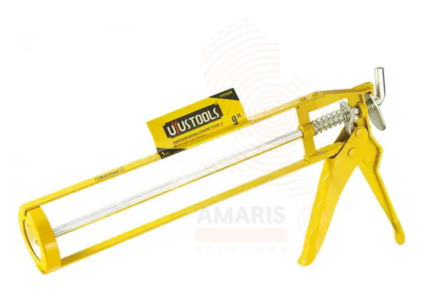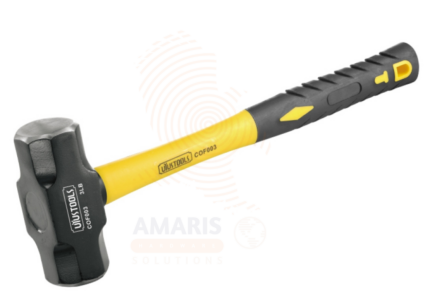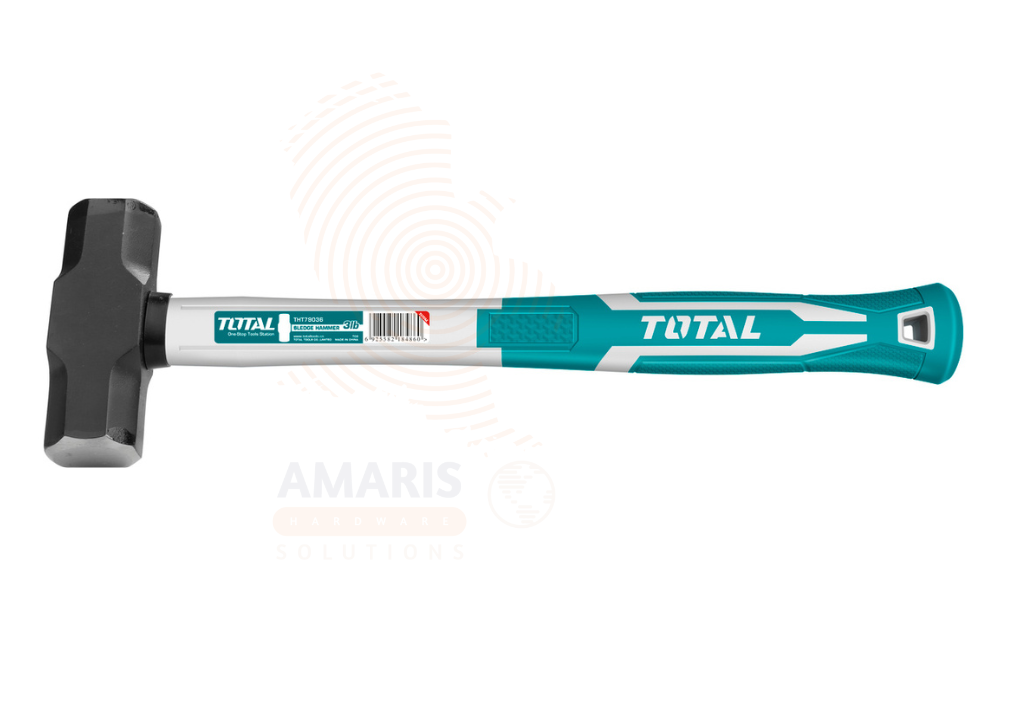
Skeleton Caulk Gun
$14.58 Original price was: $14.58.$13.85Current price is: $13.85.

Sledge Hammer - Fiberglass Handle
$53.54 Original price was: $53.54.$50.86Current price is: $50.86.
Sledge Hammer
WhatsApp Order
A Sledge Hammer is a heavy, long-handled tool typically used for tasks such as breaking, shaping, or driving objects, especially in construction and demolition. It consists of a large, flat metal head, often made of steel, attached to a sturdy handle, allowing users to deliver powerful and forceful blows to surfaces or materials. Sledgehammers are commonly employed in various industries for tasks that require significant impact force, such as breaking concrete, driving stakes, or demolishing structures.
Categories: Hammers, HAND TOOLS
Tags: construction hammer, demolition hammer, hand tool, heavy hammer, metal head hammer, sledge hammer, striking tool, woodworking hammer
Description
Table of Contents
ToggleSledge Hammer
Uses
-
Demolition: Sledgehammers are frequently used in construction and demolition to break down walls, concrete structures, or other materials.
-
Driving stakes or wedges: The heavy weight and force generated by a sledgehammer make it effective for driving stakes into the ground or splitting logs with wedges.
-
Breaking up concrete: Construction workers often use sledgehammers to break up hardened concrete or asphalt during renovation or repair projects.
-
Landscaping: Sledgehammers are employed in landscaping tasks such as removing large rocks, breaking up compacted soil, or shaping landscape features.
-
Framing and carpentry: In carpentry and framing, sledgehammers can be used for tasks like driving large nails or bolts into wood or other materials.
-
Emergency situations: Sledgehammers are sometimes used by emergency responders to gain access to buildings or vehicles in rescue operations.
-
Metalworking: In metalworking and blacksmithing, sledgehammers may be used for shaping and forming metal, especially in conjunction with an anvil.
-
Industrial maintenance: Sledgehammers are utilized in industrial settings for maintenance tasks, such as dismantling machinery or breaking apart old equipment.
-
Mining and excavation: Sledgehammers can be useful in mining and excavation for breaking up rocks or compacted soil.
-
Personal or recreational use: In certain DIY or home improvement scenarios, individuals may use sledgehammers for tasks like removing old tiles, breaking up small concrete slabs, or similar projects.
SAFETY HANDLING PRECAUTIONS
Safety Precautions
-
Personal Protective Equipment (PPE):
-
Safety glasses or goggles: Protect your eyes from flying debris or particles.
-
Ear protection: Sledgehammers can generate loud noises; use earplugs or earmuffs.
-
Work gloves: Protect your hands from blisters, splinters, or vibrations.
-
Steel-toed boots: Ensure your feet are protected from heavy objects or accidental impacts.
-
-
Proper Body Mechanics:
-
Stance: Stand with your feet shoulder-width apart for stability.
-
Grip: Hold the sledgehammer with both hands, maintaining a firm and controlled grip.
-
Posture: Keep your back straight and use your legs to generate power rather than relying solely on your upper body.
-
-
Inspect Tools:
-
Check the sledgehammer: Ensure the head is securely attached to the handle with no cracks or defects.
-
Handle condition: Make sure the handle is not splintered or damaged.
-
-
Choose the Right Tool for the Job:
-
Select a sledgehammer with an appropriate weight for the task at hand.
-
Consider using specialized hammers or tools for specific applications.
-
-
Clear Work Area:
-
Remove tripping hazards and debris from the work area.
-
Ensure there is adequate space to swing the sledgehammer without obstruction.
-
-
Communication:
-
If working in a team, establish clear communication signals to coordinate movements and actions.
-
-
Swing Control:
-
Maintain control of the sledgehammer throughout the entire swing.
-
Avoid over-swinging, as this can lead to loss of control and potential injuries.
-
-
Focus on the Target:
-
Direct your attention to the area you are striking to ensure accuracy.
-
Avoid distractions that may compromise your focus.
-
-
Two-Handed Operation:
-
Always use both hands to grip the sledgehammer for better control and power.
-
-
Training:
-
Ensure that individuals using sledgehammers are trained in their proper use and safety precautions.
-
Follow proper techniques for lifting and carrying the tool.
-
-
Emergency Preparedness:
-
Know the location of first aid supplies.
-
Have a plan for responding to injuries, and know how to contact emergency services.
-
Related products
Bi-Metal Hole Saw Set
A Bi-Metal Hole Saw Set refers to a collection of nine hole saws, each constructed with a bi-metal design. A hole saw is a cylindrical cutting tool used to create holes in various materials such as wood, metal, plastic, and more. The term "bi-metal" indicates that the hole saws are made from two different types of metals, typically high-speed steel (HSS) and a more durable alloy like cobalt. This combination enhances the hole saw's cutting performance, making it suitable for a wide range of applications and providing increased durability and longevity. The set typically includes hole saws of different sizes to accommodate various hole diameters, making it a versatile tool for professionals and DIY enthusiasts alike.
C Clamp Locking Pliers
A C clamp locking pliers, often simply referred to as locking pliers or Vise-Grips (a popular brand name), is a versatile hand tool designed for gripping, clamping, and holding objects securely. The tool features an adjustable locking mechanism that allows it to maintain a constant grip force on the object, freeing the user's hands for other tasks. The jaws of the pliers are shaped like a C-clamp, providing a strong and secure grip on various shapes and sizes of objects. This makes C clamp locking pliers particularly useful in situations where a stable hold is required, such as in woodworking, metalworking, automotive repair, and general DIY applications.
Electrician Screwdriver Set
An electrician screwdriver set typically refers to a collection of six individual screwdrivers specifically designed for use by electricians. These screwdriver sets often include a variety of sizes and types of screwdrivers that are commonly used in electrical work. The set may include Phillips and slotted screwdrivers in different sizes, as well as insulated handles to provide electrical safety when working on live circuits. The goal of such a set is to provide electricians with a versatile and comprehensive tool kit to tackle various tasks in the field of electrical work.
F-Clamp
An F-clamp, also known as a bar clamp or sliding clamp, is a woodworking tool designed for holding and securing materials in place during the process of gluing, welding, or other similar tasks. It typically consists of two parallel jaws—one fixed and one movable—that can be adjusted along a bar or rail. The movable jaw can be positioned and tightened using a threaded mechanism, allowing the clamp to firmly grip and hold objects of various sizes. F-clamps are widely used in carpentry, metalworking, and other applications where a strong and adjustable clamping force is needed to ensure precision and stability during work.
Fiberglass Open Reel Long Tape Rule
A Fiberglass Open Reel Long Tape Rule is a measuring tool designed for accurately determining distances in various applications, such as construction, surveying, and landscaping. It typically consists of a durable, flexible fiberglass tape housed on an open reel. The fiberglass material provides strength and resistance to stretching, ensuring precise measurements over extended lengths. The open reel design allows for easy deployment and retraction of the tape, facilitating efficient use in outdoor and large-scale measurement scenarios. These tapes often feature clear and legible markings, making them suitable for both personal and professional use in situations where accurate and reliable distance measurements are essential.
Flat Cold Chisel with Guard
A Flat Cold Chisel with Guard is a hand tool designed for cutting, shaping, or removing metal by striking it with a hammer. The chisel has a flat, elongated metal blade with a sharp cutting edge at one end. The guard, often made of metal or another protective material, is positioned along the sides of the blade to enhance safety during use. This guard helps prevent accidental injuries by shielding the user's hand from direct contact with the sharp edge and also provides stability to the chisel during striking. The flat cold chisel with a guard is commonly used in metalworking and construction applications.
Flat Screwdriver
A flat screwdriver, also known as a slotted screwdriver, is a hand tool designed for turning screws with a slotted (flat) head. It typically features a flat, narrow, and straight metal blade, with a handle at one end for gripping and rotating the tool. The blade is inserted into the corresponding slot in the screw head, and by applying torque to the handle, the screwdriver allows for the tightening or loosening of the screw. Flat screwdrivers are commonly used in various manual and mechanical applications for tasks such as assembling furniture, fixing appliances, and general household repairs.
Folding Hex Wrench Set
A Folding Hex Wrench Set in a Plastic Shell refers to a compact and portable tool kit that includes seven hexagonal wrenches of varying sizes, typically used for tightening or loosening bolts and screws with hexagonal sockets. The set is designed to be foldable, allowing the individual wrenches to be neatly stored within a plastic shell or casing. This design not only provides organization and easy accessibility but also enhances the set's portability, making it convenient for on-the-go use or storage in tight spaces. The plastic shell serves as a protective housing for the wrenches, preventing damage and facilitating easy transportation.


 Acrylic Sealants
Acrylic Sealants Construction Adhesives
Construction Adhesives Double-Sided Tape
Double-Sided Tape Duct Tape
Duct Tape Electrical Tape
Electrical Tape Epoxy & Resins
Epoxy & Resins Masking Tape
Masking Tape
 Automotive Wrenches & Socket Sets
Automotive Wrenches & Socket Sets Battery Chargers & Jump Starters
Battery Chargers & Jump Starters Car Jacks & Stands
Car Jacks & Stands Car Wash & Detailing Products
Car Wash & Detailing Products Diagnostic Tools
Diagnostic Tools Tire Inflators
Tire Inflators Vehicle Lighting
Vehicle Lighting Oil & Lubricants
Oil & Lubricants
 Adhesives & Sealants
Adhesives & Sealants Bricks & Blocks
Bricks & Blocks Cement & Concrete
Cement & Concrete Drywall & Plaster
Drywall & Plaster Flooring (Tiles, Wood, Laminate)
Flooring (Tiles, Wood, Laminate) Lumber & Plywood
Lumber & Plywood Paints, Primers & Coatings
Paints, Primers & Coatings Insulation Materials
Insulation Materials Roofing Materials
Roofing Materials
 Circuit Breakers
Circuit Breakers Electrical Cables & Wires
Electrical Cables & Wires Switches & Sockets
Switches & Sockets Fuses & Relays
Fuses & Relays Connectors & Terminals
Connectors & Terminals Electrical Boxes & Panels
Electrical Boxes & Panels Conduit & Fittings
Conduit & Fittings Lighting Fixtures & Bulbs
Lighting Fixtures & Bulbs Extension Cords & Power Strips
Extension Cords & Power Strips
 Anchors
Anchors Bolts
Bolts Clips & Clamps
Clips & Clamps Screws
Screws Nuts
Nuts Washers
Washers Rivets
Rivets Nails
Nails Threaded Rods
Threaded Rods
 Hammers
Hammers Measuring Tools (Tapes, Levels, Calipers)
Measuring Tools (Tapes, Levels, Calipers) Screwdrivers
Screwdrivers Pliers & Cutters
Pliers & Cutters Saws & Blades
Saws & Blades Chisels & Punches
Chisels & Punches Allen Keys & Hex Keys
Allen Keys & Hex Keys Ratchets & Socket Sets
Ratchets & Socket Sets Wrenches & Spanners
Wrenches & Spanners
 Power Tool Accessories (Blades, Bits, Discs)
Power Tool Accessories (Blades, Bits, Discs) Rotary Tools
Rotary Tools Saws (Circular, Jigsaw, Reciprocating)
Saws (Circular, Jigsaw, Reciprocating) Drills & Drivers
Drills & Drivers Grinders & Sanders
Grinders & Sanders Heat Guns
Heat Guns Nail Guns
Nail Guns Impact Wrenches
Impact Wrenches Batteries & Chargers
Batteries & Chargers
 Pipes & Fittings (PVC, Copper, PEX)
Pipes & Fittings (PVC, Copper, PEX) Plumbing Tools
Plumbing Tools Pumps & Motors
Pumps & Motors Sealants & Adhesives for Plumbing
Sealants & Adhesives for Plumbing Valves & Taps
Valves & Taps Water Heaters
Water Heaters Drainage Systems
Drainage Systems Faucets & Fixtures
Faucets & Fixtures Hoses & Tubing
Hoses & Tubing
 Hinges & Latches
Hinges & Latches Hooks & Brackets
Hooks & Brackets Window Hardware
Window Hardware Chains & Cables
Chains & Cables Casters & Wheels
Casters & Wheels Shelving & Storage Systems
Shelving & Storage Systems Door Handles & Locks
Door Handles & Locks Drawer Slides & Cabinet Hardware
Drawer Slides & Cabinet Hardware
 Personal Protective Equipment (PPE)
Personal Protective Equipment (PPE) Respirators & Masks
Respirators & Masks Safety Glasses
Safety Glasses Safes
Safes Security Cameras
Security Cameras Gloves
Gloves Helmets
Helmets Ear Protection
Ear Protection Fire Safety Equipment
Fire Safety Equipment Locks & Padlocks
Locks & Padlocks Motion Sensors & Alarms
Motion Sensors & Alarms
 Garden Fencing
Garden Fencing Garden Furniture Hardware
Garden Furniture Hardware Lawn Mowers
Lawn Mowers Trimmers & Edgers
Trimmers & Edgers Shovels & Spades
Shovels & Spades Rakes & Hoes
Rakes & Hoes Pruning Shears & Loppers
Pruning Shears & Loppers Watering Systems (Hoses, Sprinklers, Nozzles)
Watering Systems (Hoses, Sprinklers, Nozzles)
 Interior Paints
Interior Paints Paint Brushes & Rollers
Paint Brushes & Rollers Paint Strippers & Thinners
Paint Strippers & Thinners Paint Trays & Accessories
Paint Trays & Accessories Exterior Paints
Exterior Paints Spray Paints
Spray Paints Primers & Undercoats
Primers & Undercoats Varnishes & Stains
Varnishes & Stains
 Gaskets & Seals
Gaskets & Seals Hydraulic Fittings
Hydraulic Fittings Industrial Fasteners
Industrial Fasteners Industrial Hoses
Industrial Hoses Lubricants & Greases
Lubricants & Greases Metal Sheets & Bars
Metal Sheets & Bars Bearings & Bushings
Bearings & Bushings Belts & Pulleys
Belts & Pulleys
 HVAC Filters
HVAC Filters Insulation for HVAC
Insulation for HVAC Air Conditioners
Air Conditioners Refrigerants
Refrigerants Ventilation Ducts & Fittings
Ventilation Ducts & Fittings Thermostats & Controllers
Thermostats & Controllers Fans & Blowers
Fans & Blowers
 Pegboards & Hooks
Pegboards & Hooks Shelving Units
Shelving Units Storage Bins & Containers
Storage Bins & Containers Toolboxes & Tool Chests
Toolboxes & Tool Chests Workbenches
Workbenches Drawer Organizers
Drawer Organizers Labeling Supplies
Labeling Supplies
 Welding Accessories (Clamps, Brushes)
Welding Accessories (Clamps, Brushes) Welding Electrodes & Rods
Welding Electrodes & Rods Welding Helmets & Gloves
Welding Helmets & Gloves Welding Machines
Welding Machines Soldering Irons & Stations
Soldering Irons & Stations Flux & Solder Wire
Flux & Solder Wire
 Generator Accessories
Generator Accessories Inverters
Inverters Portable Generators
Portable Generators Power Inverters
Power Inverters Transfer Switches
Transfer Switches Diesel & Gasoline Generators
Diesel & Gasoline Generators
 Transport Equipment: Carts, Dollies, and Hand Trucks
Transport Equipment: Carts, Dollies, and Hand Trucks Storage Solutions: Pallets, Racks, and Containers
Storage Solutions: Pallets, Racks, and Containers Lifting Equipment: Hoists, Cranes, and Jacks
Lifting Equipment: Hoists, Cranes, and Jacks Conveyors and Accessories: Belts and Rollers
Conveyors and Accessories: Belts and Rollers











